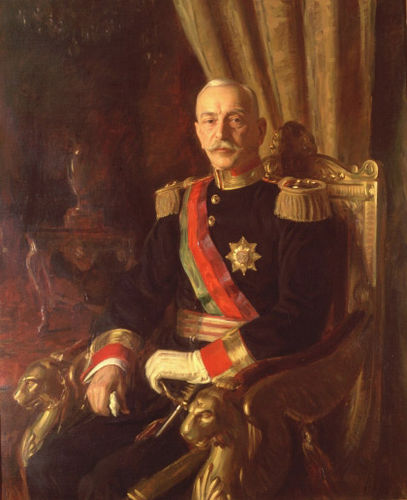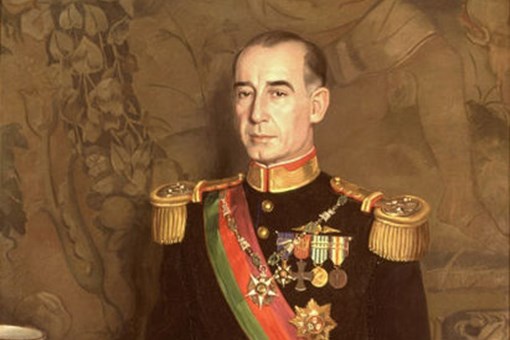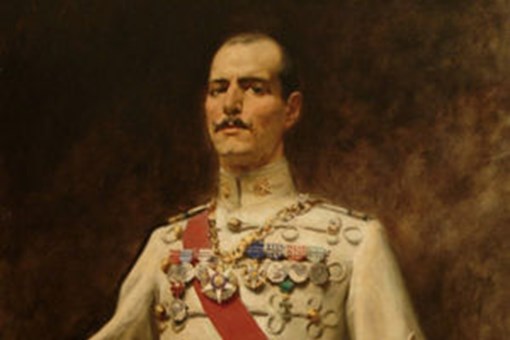António Óscar de Fragoso Carmona
Born in Lisbon in 1869. Died in Lisbon on 18 April 1951.
Father: Inácio Maria Machado de Morais Carmona (army general); Mother: Maria Inês de Fragoso Corte-Real.
Wife: Maria do Carmo Ferreira da Silva.
Training: Military School (1882-1888); Army Academy (1889-1892).
CAREER
Profession: Cavalry officer – lance-corporal (1892), second-lieutenant (1894), captain (1910), major (1910), lieutenant-colonel (1916), colonel (1919), general (1922); marshal (1947).
Positions: member of the Army Reform Commission (1911); instructor at Central Officers School (1913-1914); Director, Cavalry School of Torres Novas (1918-1922); Commandant IV Division - Évora (1922-1925); Minister of War (1923); President of the Ministry (1926-1928); Foreign Minister (1926).
ELECTIONS AND POST-PRESIDENTIAL PERIOD
As President of the Ministry and the office being vacant, Carmona was implicitly the president since 9.7.1926; he was appointed provisionally by decree of 16.11.1926; elected president by direct suffrage (25.3.1928); successively re-elected with no opposition (17.2.1935, 8.2.1942, 13.2.1949), but on the latter date the opposition presented General Norton de Matos, who withdrew before the voting. He was President from 16.11.1926 to 18.4.1951.
PUBLISHED WORKS
O novo regulamento para a Instrução Táctica de Cavalaria in Revista Militar, n.º 11, November 1913; "Prefácio", in Leopoldo Nunes, A Ditadura Militar, Lisbon, 1928.
He was the opposite of Gomes da Costa who was the hero of the African campaign whilst Carmona was a chair-bound officer, familiar with the corridors of power, the general of the "virgin sword" who stayed behind when his unit was sent to Flanders and sent his second-in-command in his place. He stood out for his political skill, ease of relationship, prestige of his family (his grandfather was a hero of the Peninsular War), but also for his technical competence.
He was typical of the officers who took advantage of the scarcity of republican officers and offered his services to the new regime – albeit with reservations but also having calculated the matter carefully. As a result he rose rapidly through the ranks. In his first period in power, as war minister, he repressed the “radical plot” (13.12.1923). What gave him national projection, however, was his role as military prosecutor in the trial of the "Sala do Risco" for those responsible for the events of 18.4.1925, when he asked for and obtained the absolution of the defendants, arguing that “the country was sick” and therefore needed sword-bearing surgeons.
He was prudent concerning 28.5.1926 and when Sinel de Cordes obtained his last-minute agreement to join, this helped consolidate the movement. When he resigned as foreign minister (after obtaining the essential English recognition of the new situation with no great difficulty and therefore with no great merit), the reaction acted as a catalyst for Gomes da Costa’s removal. Carmona then accumulated his position of head of State wit that of head of the ministry. His appointment by decree to the presidency marks the clear break with the tenuous link that the new situation might still appear to maintain with republican legality, following the resignation of Bernardino Machado and the clause establishing that the President of the Republic should be replaced by the president of the ministry in the very deed of the resignation. In fact, when Gomes da Costa was deposed and refused to transfer his powers, this had become even more dubious.
His direct election to the Presidency, like with Sidónio, established and tried to lend legitimacy to the break.
He played a key role in the troubled political and military process that led to the institutionalization of the New State, with his interventions in favour of Salazar. He did not know Salazar personally when the latter was appointed finance minister (27.4.1928) but soon gained his confidence. It was Carmona who got him, a civilian, appointed president of the ministry (5.5.1932). Once the regime was established and the new Constitution approved (11.4.1933) Carmona’s active intervention in current affairs was greatly reduced, which some foreign observers, such as the American ambassador, associated to his illness (1935), but the fact is that this suited him and he continued to be a key figure in the consolidation of the regime in its military component.
Carmona had to agree to Salazar holding all the key portfolios given the complex situation arising out of the Spanish Civil War (1936-1939) and World War II (1939-1945) and eventually there was conflict between the two. Carmona even mentioned that he felt coerced and contacts were established with members of the opposition – in MUNAF (Antifascist Unitarian Movement) and MUD (Democratic Union Movement), military men such as M. Cabeçadas, N. de Matos, C. Soares, but also civilians such as J. Magalhães Godinho. Some say that he actually asked which portfolios they would like to have and forwarded the Government a petition by the opposition demanding democratisation (January 1946), with a note asking them to “study” it. At their trial the military conspirators – there were several conspiracies between 1943 and 1947 – said in their defence that they had been encouraged in their actions by the Head of State. In fact, the contacts were the result of the English bringing pressure to bear on Carmona and encouraging the conspirators to use him in the putsch within a well-defined context and with well-defined objectives. The first was the question of the delay in ceding the bases in the Azores and the second the demand to stop exporting wolfram to Nazi Germany (between mid- 1943 and late 1944). These issues having been settled by Salazar to the Allies’ satisfaction, like them Carmona stepped back from initiatives that had scant possibility of success.
Carmona’s ambiguity vis-à-vis the opposition and theirs towards him, in this period, seem to mark the opinion that Salazar himself has of Carmona, when he describes him to Franco Nogueira (Um Político Confessa-se, p. 179): "A prince. An enchanting, attractive and insinuating figure [...] all the long years we worked together I was never really sure that he was on my side. I am even convinced that most of that time he was not." In fact, Carmona was not an unconditional supporter, which was what Salazar meant by “being on his side”. Even after this crisis, however, their relationship continued to offer mutual advantages. Following a display of public distancing – Salazar would be absent from all ceremonies attended by the President – reconciliation came when Santos Costa awarded Carmona the marshal’s baton. As opposed to 1935, Carmona accepted it (19.4.1947) and with the support of the União Nacional (18.12.1948) ran again for president in the 1949 elections.
This was the first of three occasions (1949, 1951, 1958) when the opposition, taking advantage of the relative post-war openness, submitted candidates (9.7.1948). The choice fell on one of the soldiers involved in the above-mentioned conspiracies – General Norton de Matos (1887-1955), an embarrassing subject used against Carmona in the election campaign. The “free” campaign was officially fixed (from 1.1 to 11.2.1949). Norton de Matos protested with telegrams and letters to Salazar regarding the independent inspection of the electoral rolls and the voting, in his last letter (30.12.1948) saying - "under such conditions you can only do it with candidates who will agree to cooperate with this pretence of free elections" – and withdrew (7.2.1949).
Carmona seemed to be the ideal solution for three essential issues of the regime: relations between the military; relations of the military with the politicians; and relations between monarchists and republicans. He exercised symbolic and arbitrational power and was a maker of consensus. It is doubtful whether Salazar could have removed Carmona as he did Craveiro Lopes. It also seems unlikely that Carmona would at any time, except in the short period (1943-1944) when he had the Allies’ support, have made any effort to remove Salazar, even if in he had had sufficient force during the 40s in an army that was increasingly dominated by Santos Costa. He died during his fourth term in office and was buried at the National Pantheon in a state funeral with all pomp. He had been President of the Republic for a quarter of a century. He was the President who served the longest and is likely to remain so, as the current legislation limits the number of successive terms.



